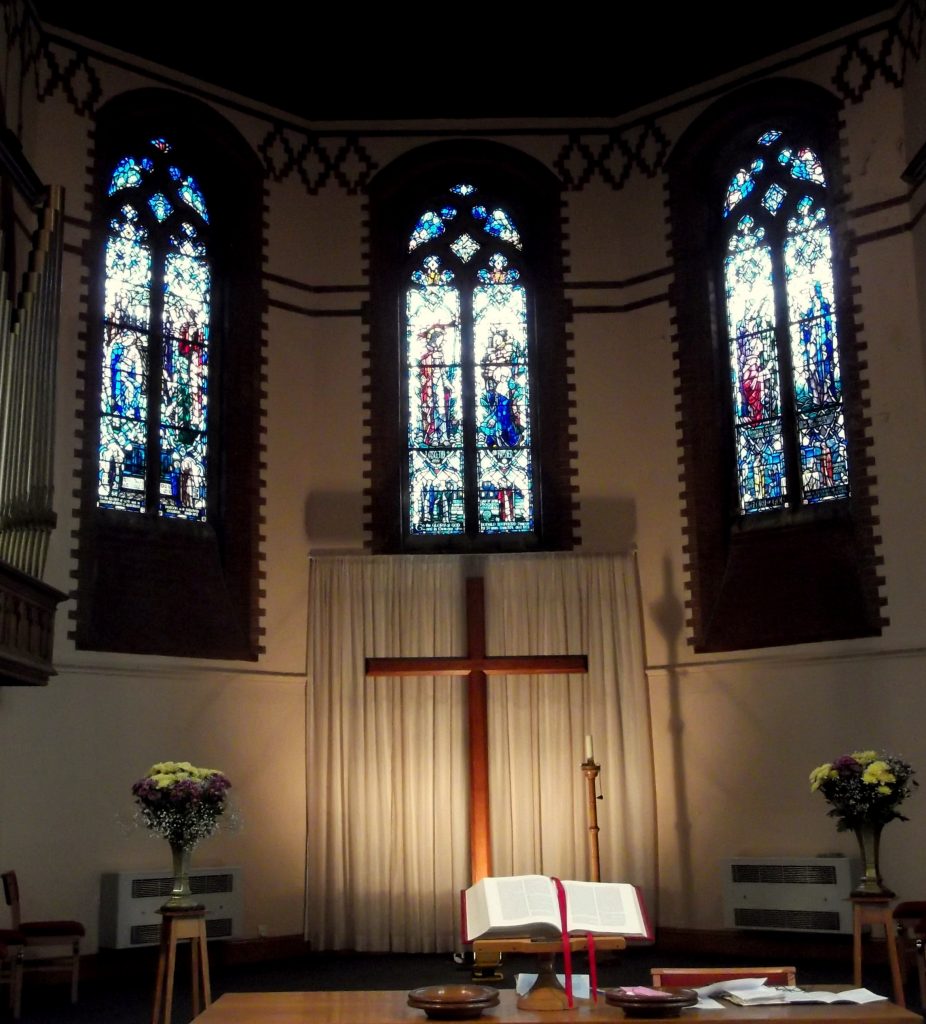Stained Glass in Avenue St Andrew’s

The artist
All our windows are the work of Gordon McWhirter Webster (1908 – 1987). He was the son of Alfred A. (Alf) Webster, one of the great Scottish stained glass artists of the late Victorian period. Gordon took over his father’s business in 1929. He was initially influenced by his father’s approach, but from the 1930s onwards he developed his own style. He has windows in many a parish church in Scotland, as well as in St Salvator’s Chapel at the University of St Andrews. One of his best works, a great rose window depicting Christ in Majesty, from St Mary’s Church, Partick, is now in the People’s Palace collection in Glasgow, and was a focal point in the Interdenominational Church at the Glasgow Garden Festival in 1988.
The windows
The left window – Nativity
 Photo by Sue Hill
Photo by Sue Hill
In memory of Anne Ackerley, deacon and beloved church member of Avenue Congregational Church, who died in 1957.
This window shows the beginning of Jesus’ life. Mary cradles him, with Joseph standing behind. In the background are the uprights and thatched roof of the stable where he was born, and the star which marked his birth. On the right are three shepherds, who have come to worship the baby. Above them are singing angels, representing the heavenly choir.
Below is the story of Mary and Joseph presenting Jesus in the Temple, in thanksgiving for his birth. The old man Simeon holds the child, and speaks the words: ‘Lord, now lettest thou thy servant depart in peace.’ Mary and Joseph hold a cage of doves for sacrifice – a tradition Jesus would later question. In the background is the Altar of the Temple, with the tablets of the law surmounted by golden cherubim.
The middle window – Resurrection

Photo by Sue Hill
In memory of Ronald Shepherd, a founding deacon of Avenue Congregational Church who died in 1953.
This window features the new life God gave Jesus after his death. At the top are Jesus’ crowns of thorns and of glory. The pelican on the right feeds her young with her own blood – a symbol of self-sacrifice. The phoenix on the left rises from its ashes – a symbol of resurrection.
Christ is in sacrificial red. You can see the three crosses of Calvary behind. Mary Magdalene kneels and behind her is the walled city of Jerusalem. Jesus’ words are: ‘I ascend unto my Father’.
Below are two walkers on the road to Emmaus on that Sunday evening. They are joined on the road by the risen Christ, but do not recognise him. It is only when he accepts their hospitality and breaks bread with them that they understand who he is. He vanishes from their sight, and they rush back to Jerusalem to tell Jesus’ friends.
The right window – Sending out disciples

Photo by Sue Hill
In memory of sisters Edith and Gertrude Barling.
The bottom panel depicts the sisters Mary and Martha. We see Mary sitting listening to Jesus on the left, while Martha works in the kitchen.
The main panel shows Jesus’ disciples, both women and men, being commissioned to go out and spread his message about God’s coming kingdom. The inscription, from Matthew 10, reads, ‘Behold, I send you forth as sheep in the midst of wolves.’
